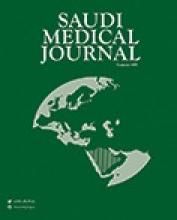Abstract
OBJECTIVE: To determine the incidence of hypothermia during surgical procedures when adequate methods of preserving normothermia are applied.
METHODS: A prospective study in which patients ASA I-IV presented for surgery at the Armed Forces Hospital, Wadi Al-Dawasir, Kingdom of Saudi Arabia during the period from July 2000 until February 2003, in whom body core temperature was between 35-37 degree, were included. Ambient temperature of the operating room was thermostatically adjusted to record 26 degree and 24 degree if patients were less than 10 year-old or above. Depending on type of surgery; the patients were provided with space blankets and were lying on warm mattresses. Fluid or blood warmers and forced-air surface warming were used when needed.
RESULTS: There were 3886 surgical patients operated upon during the period of the study. Their average age was 34.5 years (range 15 days to 104 years). Sixty patients (1.54%) developed intraoperative hypothermia (core temperature <35°C) and were admitted to the intensive care unit for monitoring and gradual rewarming. There was no mortality amongst them. Out of those 60 patients, 17 (28.3%) expressed dissatisfaction on this part of the service, but the overall patient's satisfaction scored 99.6%.
CONCLUSION: Aggressive measures must be adopted to preserve normothermia as prevention of intraoperative hypothermia improves patient's outcome. All patients should have their core body temperature monitored during surgery. However, application of available methods of keeping normothermia reduces the incidence of intraoperative hypothermia but does not abolish it completely. Hypothermic patients should be closely monitored during gradual rewarming, preferably in the intensive care setting. A protocol for prevention of intraoperative hypothermia must be adopted by all operating theaters.
- Copyright: © Saudi Medical Journal
This is an open-access article distributed under the terms of the Creative Commons Attribution-Noncommercial-Share Alike 3.0 Unported, which permits unrestricted use, distribution, and reproduction in any medium, provided the original work is properly cited.






